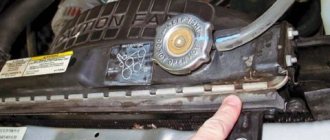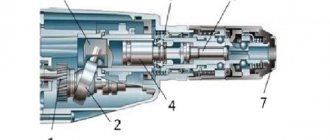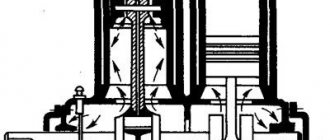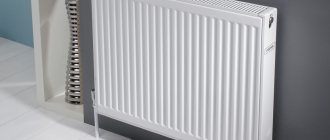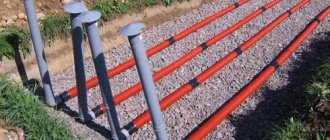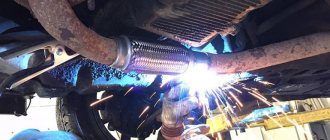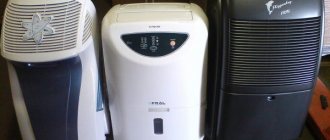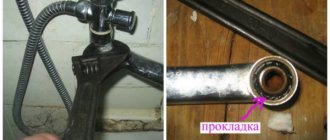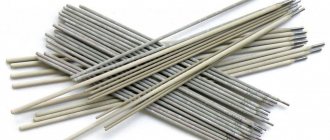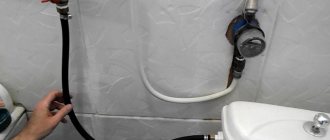Let's figure out what cold welding is for cast iron batteries
In simple terms, cold welding for cast iron radiators is the gluing of bases without preheating. This glue has a special composition, most often it consists of epoxy resin and hardener. After drying, a seam made from such an adhesive composition has the properties of metal. This welding method can withstand heavy loads, high temperatures, and can be used at sub-zero temperatures, so it is considered very reliable for cold welding battery repairs.
Cold welding - what is it, application for heating system
The technology of gluing metals has been used since ancient times; as a result, permanent connections were created without the risk of oxidation of parts. Cold welding is understood as a technological process of joining products without additional heating, as a result of which their surfaces undergo plastic deformation. The latter destroys the film of oxides, which previously prevented the metals from joining. Welding occurs in a short period of time as a result of setting. In appearance, this adhesive composition resembles putty and is made on the basis of epoxy resin.
Cold welding is now widely used to join the following metals:
- cast iron;
- stainless steel;
- copper;
- tin;
- aluminum;
- nickel;
- lead.
Using welding glue, you can repair steel and aluminum batteries, cast iron radiators, and bimetallic radiators. Polymer products for pipelines can also be welded in this way. We are talking about propylene pipes, which are used for installing a heating system. If the technology is strictly followed, it is possible to seal a pipe, riser, or radiator with any defect, although the strength of the joint will be somewhat inferior to that after electric arc welding.
How to prepare a battery for cold welding
To understand whether it is possible to cover a battery with cold welding and for high-quality repair of a cast iron battery with cold welding, it needs to be prepared for this. How to seal a heating radiator using cold welding:
- To cover a battery with cold welding, the surface that needs repair must be cleaned using sandpaper, as the roughness will increase the level of adhesion to the adhesive. Many people ask, is it possible to cover a hot battery with cold welding? If you can paint heating radiators while they are hot, then it is better not to use cold welding with hot radiators. The radiator temperature should be room temperature.
- Then degrease. Particles of dirt and dust, on the contrary, will worsen the quality of gluing.
- When using hard welding, keep your hands wet to prevent the compound from sticking. When using a liquid solution, you need to act very quickly.
- We apply the solution to the surface to be repaired and do not forget that it is better not to use cold welding for heating with hot radiators.
- For better adhesion and gluing, you need to secure the gluing area with a tourniquet or clamp.
- The curing time of the composition is from 15 minutes to one hour, it depends on the chosen welding grade, after which it can be processed, drilled, etc. Final strength also depends on the brand, but is usually achieved after 24 hours.
Soldering the cooling radiator
1).
First of all, we need to remove the radiator. Drain the coolant into a special container, disconnect all the pipes, tighten the fastening bolts and remove the assembly. 2). Next, we need to determine exactly where the leak is located.
- Visually. Before removal, first start the engine, warm it up to 80 degrees and try to find the leak location with a glance. After dismantling, we also carefully inspect the unit. In cases with a large defect, finding the leak will not be so difficult.
- If something didn't work out. We lower the dismantled radiator into the bathroom, and connect a working compressor to inflate the tires to one of the pipes. The exact location of the defect can be determined by air bubbles.
3). After this, we will need to decide on the soldering method.
- A small test. In cases with a small breakdown, pour solder onto the problem area.
- Extensive damage. In cases with relatively extensive damage, you will need to install a patch and solder it along the contour.
Instructions
- Soldering iron (from 100 W and above);
- Flux;
- Solder;
- We clean the soldering area from dirt and dust and dry it.
- Next, we apply rosin or soldering acid here (this is the most preferable option).
- In cases of a small hole, distribute the tin in an even layer over the treated area.
- If the damage is large, then install a copper or brass patch, and then carefully solder it around the perimeter. The patch can be cut from an old cooling radiator. Low-melting solder is recommended to use grades POSSu 30-0.5 or POSSu 25-2.
- If the radiator is aluminum, then it has its own characteristics. The entire process can be disrupted by the instantly formed oxide film, and therefore it is recommended to use active flux and aluminum solder.
- If the tube is damaged and you can access it with a soldering iron, warm up the soldering area and carefully remove the tube. Next, depending on the nature and area of the damage, we either solder it or replace it with a new one.
- If, however, there is no external access in the tube, then you can proceed as follows. We insert a heated rod of a suitable diameter into the tube. After the solder softens, remove it along with the tube.
Types of cold welding for batteries
When a battery breaks down, many people ask who to complain about cold batteries in the apartment and how to seal the battery with cold welding and is such a repair durable? Any professional in this matter will tell you that a seam made using cold welding is reliable. Of course, a lot will depend on the choice of adhesive composition. They are divided into two types:
- Liquid. When purchasing this type of cold welding, please note that this composition is two-component. This means that there are two tubes in the package. They must be mixed before use. Please note that after mixing, the solution is stored for no more than 20 minutes.
- Solid. The feel of this type of welding is indistinguishable from ordinary plasticine for children. More often it is a two-part bar, which must also be mixed before use. There are also one-component bars, then you don’t need to mix anything, you just need to knead them before use.
How does a radiator work and what threatens us if it breaks?
The radiator design includes pipes with passages to provide space for communication with air. The principle of its operation is to prevent overheating of the engine, the average temperature of which is 2000 degrees Celsius. However, it produces more heat during combustion. In this case, the function of the radiator is to remove part of this heat, and a very significant one at that . How does this happen? This is where we remember the well-known name of one of the automotive fluids - antifreeze.
Water mixed with antifreeze surrounds the engine through the cylinder block and heads, thereby absorbing its heat. The liquid moves to the reservoir, passes through the pipes, losing heat into the air. After this stage, cold air flows from the radiator to the engine and the process repeats again. It would seem that the system is closed, rather simple, how can it break? But there are not so few factors, let's decide in what cases the radiator becomes unusable, and how to notice it.
Which cold welding machine should I buy?
In order to correctly buy cold welding for cast iron radiators, when choosing, you should pay attention to the fact that it differs in composition. Not every cold weld can be used to seal leaks in batteries. Depending on the composition, cold welding is used for different purposes:
- Multifunctional. This welding can be used to repair any materials: metals, wood, plastic. But it is considered the least reliable.
- For metals. This type of welding has a special composition that, when working with metals, securely holds them together.
- Special cold welding for batteries and pipes. It firmly glues parts and does not lose its properties even at a temperature of 1500 degrees.
- Automotive. It is also used for fastening metals, but has a more gentle composition.
- Cold welding for underwater repairs.
Be sure to check the packaging for the temperature conditions at which the seam retains its properties. The higher the temperature, the more reliable the welding. More often, instructions for adhesive compositions indicate a temperature of 260 degrees, but as practice shows, such a seam retains its qualities only at room temperature. Therefore, to avoid this situation, you need to choose cold welding, where the operating temperature will be 1300 degrees and above. Such solutions are the most durable.
Methods for repairing cast iron radiators using cold welding
Before starting to describe methods for repairing a battery using cold welding, it should be noted that cold welding is a temporary remedy for eliminating an individual leak. A repaired welding leak can last for several seasons with normal handling, but the battery can only be properly repaired by disassembling it and replacing the broken section with a new one.
Another point that you need to pay attention to is the size of the patch and the possibility of repairing various damages. If a small leak has formed in a section, then cold welding will cope with this task quickly and efficiently. Another thing is when a large gap has formed in the metal, you will have to use additional reinforcement - in addition to the first layer applied by cold welding, you will have to use liquid glue and make a bandage. And the most difficult case is when an entire fragment of metal breaks off due to an impact. Cold welding cannot handle such repairs; here you must immediately shut off the coolant supply and call a repair team.
Repair of small leaks on the vertical surface of the section
If a leak has formed on the outer or inner surface of a section and the size of the crack does not exceed 1-2 cm in length, in addition to cold welding, you will also need a metal brush, 100 and 200 grit sandpaper and paint solvent or alcohol.
Before starting work, the supply and drainage of coolant to the battery is shut off and, if possible, water is drained from it.
Use a metal brush to remove the paint at a distance of 1-1.5 cm on both sides of the crack. After this, first with 100-grit sandpaper, and after 200, sanding is done so that the spot at the site of the future patch is sanded down to bare metal.
After this, glue is prepared and the surface of the radiator is degreased. Cold welding for a heating battery is applied to the surface of the patch so that there is a gap of 1-2 mm between the cleaned metal and the paint on the surface of the battery.
After applying the glue, it is actively pressed and left to crystallize for the time specified in the instructions.
Repairing leaks at the joints of radiator sections
This repair case allows for higher quality leak sealing. The fact is that repairing pipes and cylindrical surfaces is easier than repairing a crack on a flat surface. In this case, in addition to the usual plastic mass, you can later use two-component glue with an additional bandage to increase the strength of the connection.
When repairing the junction of sections, not only the leak site is cleaned, but the entire circumference of the junction. The fact is that an incorrectly made connection of sections with an existing leak will subsequently allow coolant to flow around the entire circumference, since the mechanical tightness in it is broken.
The sequence of actions here is as follows:
- The battery is disconnected from the coolant supply;
- The entire surface around the circumference of the joint is cleaned;
- An adhesive composition is being prepared;
- The area where the glue is applied is degreased;
- A layer of cold welding is applied along the entire circumference of the joint of the sections;
- After the first layer has dried, a liquid glue composition is prepared;
- A layer of liquid adhesive is applied to the area, followed by a fiberglass strip and another layer of adhesive applied over it.
- To consolidate the result, 3-4 turns are made with mandatory glue impregnation;
- After this, a metal clamp is placed on top and secured with a screw.
Repairing leaks in nuts and fittings
For repairs in these places, plastic cold welding for radiators is usually used. As in previous cases, the leak site is cleaned from paint to metal. When cleaning, it is recommended to remove part of the tow from the joint to a depth of 1-1.5 mm, this will make it possible to strengthen the gluing area by cold welding.
After cleaning and degreasing, the process of preparing and applying cold welds is identical to the previously described cases.
Thus, cold welding is currently the optimal means for temporary repair of cast iron heating radiators.
Tips for repairing a plastic car radiator
Vehicle cooling systems are extremely important components that ensure the normal functioning of the most heavily loaded components and parts of the vehicle.
If in the early periods they were made entirely of various types of metal, today we increasingly have to deal with plastic samples.
Although they are somewhat more dynamically stable than some metal radiators, significant problems can arise when repairing them
A liquid circulates inside the radiator , which removes heat from the car engine through it.
As a result, if the operation of this component is disrupted, the engine simply overheats above the specified norm and may even jam.
The best heat removal effect is achieved only with a constant incoming air flow, which is ensured by the front placement of components.
At the same time, the radiator is a rather vulnerable element . Even a minimal impact can lead to significant mechanical damage.
Argon arc technology
Argon welding is used to repair tanks with fairly thick walls. An attempt to weld damage to honeycombs with a metal thickness of 0.3 mm can lead to its increase. However, a high-class specialist sometimes manages to successfully cope with this task.
Argon arc welding of a car radiator
To weld aluminum radiators, filler rods made of the same material and non-consumable electrodes are used to create an arc. To prevent oxides formed from the interaction of aluminum with atmospheric oxygen and splashing from interfering with the process, it is produced in an argon environment. To weld a car radiator from copper, an appropriate rod is used for the additive.
Of all the repair methods, welding in an argon environment is the most reliable. The strength of the seams created is not inferior to the factory one. However, for this you will have to contact a car service, since using this technology at home without special equipment and experience is impossible.
Restoring a plastic radiator
More and more often today there are cars equipped with coolant tanks
Of course, this is largely practical, since the occurrence of any oxides and destruction by chemical action from the outside is almost completely excluded.
However, the appearance of even a small crack as a result of mechanical stress can lead to active leakage of coolant , a drop in the overall functionality and reliability of the system.
Features of radiator repair
The first solution that comes to mind for anyone who finds a plastic radiator under the hood is the use of glue .
However, many car owners have already encountered the fact that even universal samples are completely powerless when it comes to creating a durable patch on the radiator .
Even if such a patch can be applied, after some time the gluing still forms a crack and antifreeze begins to ooze out of it.
The reason for this is that the heatsink structure is made from extremely slippery hydrophobic plastics . The material helps fluid circulate inside, but almost completely eliminates traditional bonding methods.
Of course, the components are susceptible to constant and extremely severe temperature changes, as well as vibrations and significant pressure in the system itself.
Many experts talk exclusively about the need to completely replace the component , given that it is also somewhat cheaper than metal samples.
However, for various reasons, many may not have this opportunity, so temporary effective measures to eliminate leaks are of particular value.
There are several possible options for restoring the tightness of this unit. Considering that almost all types of adhesives are not suitable for this, experts recommend using the capabilities of the polymer material itself.
In particular, the first recommendation can be called soldering. It’s worth noting right away that radiators are made of special heat-resistant plastics, however, they can also be excellently soldered using a regular soldering iron.
An alternative option is the use of cold welding. This joining method does not require special heating, while the plastic mass itself includes special polymer resins, chemical additives and metal fillers, which provide not only strong but also heat-resistant seams .
Although the restoration processes themselves do not require special skills or overly expensive equipment , nevertheless, the result cannot be called particularly durable.
It’s worth saying right away that cold welding may not be suitable for many owners of cars with a plastic radiator.
Although this patch is better than any glue, it is still not strong enough to provide a lasting effect . With this solution, for example, you can get to the nearest car service center , but driving with such a patch for months will no longer be possible.
If there is very little damage, you can try to seal the component using specialized glue .
, the two-component adhesive 3M DP8005 showed good results . It is based on acrylic , which connects difficult-to-glue plastics and even polyethylenes well.
Using this glue you can repair small cracks in the radiator. High resistance to aggressive solutions and high temperatures provides a successful, albeit temporary solution to the problem.
Of course, such glue cannot be called cheap. In addition, you can use Horsh welding adhesive, also designed for joining a variety of plastic products and filling cracks. The ability to withstand high temperatures and pressures is its main advantage.
Internal radiator repair with a chemical agent
Most experts do not recommend resorting to this method. However, when you need to drive urgently, and antifreeze is flowing on the asphalt, you don’t really have much of a choice.
By the way, the method will only work with minor cracks. If there is a stone sticking out of the radiator, then all work will have to be cancelled.
Considering that all chemicals work according to the principle of a long-proven old-fashioned method, it will be easier to turn to the original source.
Related article: Why oil leaks from the engine, how to find and fix the leak
Back in Soviet times, when the Chinese chemical industry did not pay attention to the problems of car enthusiasts, mustard powder came to the rescue. It is poured into the neck (with the engine running). Since the fluid in the radiator is hot, it swells and fills the crack.
If mustard does not inspire confidence, you can buy a product special for this purpose at a car dealership.
They are called differently: powder reducer, radiator sealant, etc. But, as already mentioned, it is better to use other methods, because it is impossible to predict exactly how and where the powder will settle, and it can easily clog several tubes.
How to seal a heating radiator
How to seal a heating radiator
Miraculously, a problem with an aluminum heating radiator arose when frosts hit all over Russia. Moreover, the radiator leaked late at night. I woke up several times at night because the heating radiator was making noise. I also thought that this was not without reason and was very similar to depressurization. Alas, I was not mistaken - in the morning there was a decent puddle under the radiator on the laminate floor. Initially I thought that the problems were related to the faucet, but then I discovered swollen paint on the side of the radiator from under which water was oozing.
It was possible to determine the location of the leak by the swollen paint
After removing the swollen paint with a flat screwdriver, I saw the cause of the leak - two small holes.
Two holes in the left section of the radiator
Most likely, the microscopic hole appeared a long time ago, since just a year ago, a noise similar to a clicking emanated from this battery. I kept blaming Mayevsky's damaged faucet, but even after replacing the faucet, the noise did not stop.
What to glue with?
After searching for information on the Internet, I decided to buy cold welding. There was no choice, so I took what was in the store - “Almaz universal cold welding adhesive.”
Do-it-yourself car cooling radiator repair
Repairing a cooling radiator with your own hands is a completely doable job, but in some cases it is expensive. However, under some conditions, no matter how expensive the repair, it is cheaper than buying a new one, especially if you can’t eat the one you need during the day.
Core repair
This repair is possible not only for the VAZ 2107, but also for other cars, and it can be caused by an object (stone) flying through the radiator grille, or a tube simply burst due to time, a fan flying apart, or simply accidentally pierced with a screwdriver.
Repair can be very difficult, especially for aluminum radiators, but it is possible.
If it is possible to determine which tube is leaking, then repairs are carried out depending on the type of radiator. Copper (brass) radiators are the most repairable.
Copper or brass radiators are easily soldered, both the tubes themselves and the baths. Copper tubes are moderately flexible and sometimes it is possible to simply twist them and, by flattening them, seal the leak.
Repairing an aluminum car radiator is more difficult, but it is possible to do it yourself. Firstly, there are special fluxes that allow you to solder aluminum honeycombs, and secondly, there are other ways to seal a leak. This can be cold welding, as well as repairing the radiator with epoxy resin. Although I would not rely on these methods, as they can lead to a re-leak at the most inopportune moment.
Radiator soldering
This type provides the highest quality repairs, but unfortunately it is more labor-intensive, although no special equipment is required.
Radiator soldering materials
Recommended for soldering cooling radiators, interior heaters (heater radiator) and air conditioners. To work you will need:
- soldering iron with a power of at least 100 W;
- soldering acid or other flux, special flux for soldering aluminum;
- solder;
- metal brush.
The technique is not complicated; after determining the location of the leak, you should:
- provide free access of the soldering iron to the soldering area;
- clean the soldering area;
- treat the area with flux.
- Heat the soldering iron thoroughly, heat the solder evenly and pour it over the soldering area.

